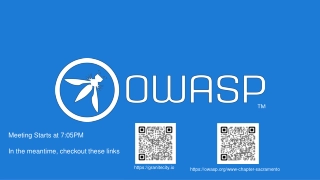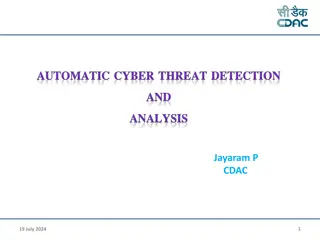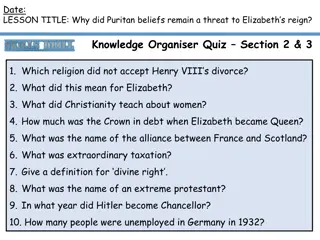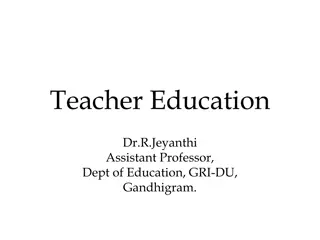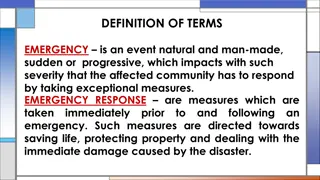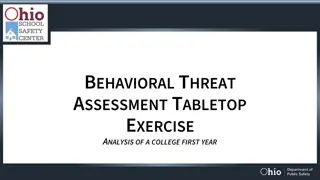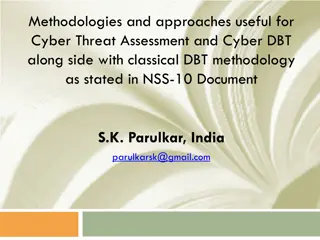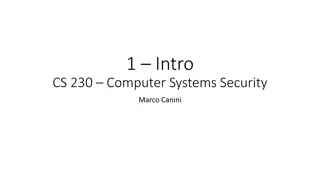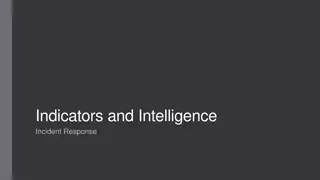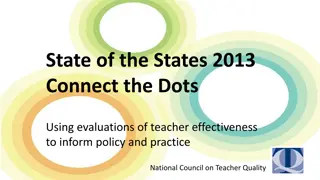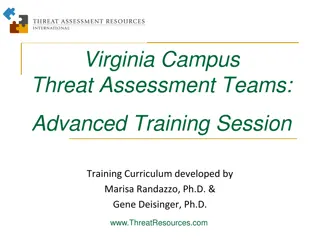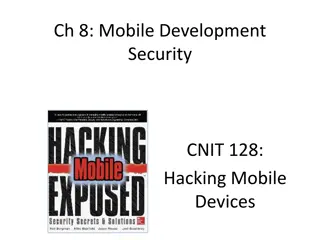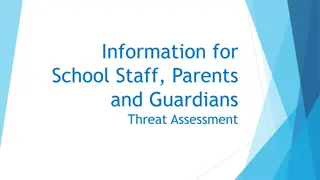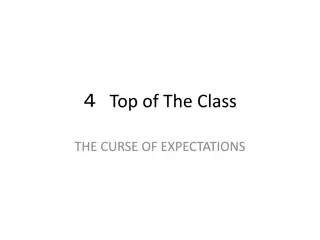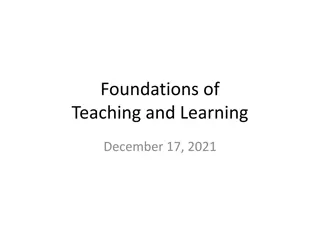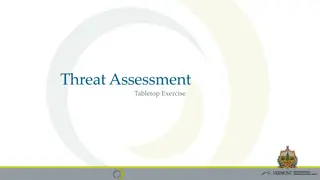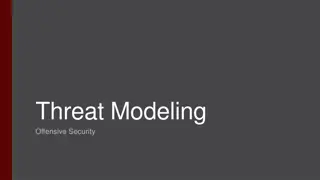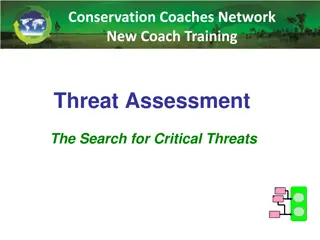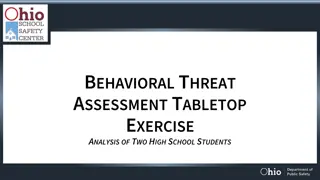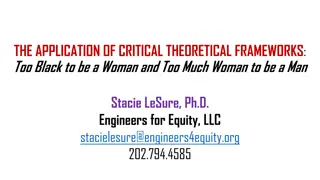Understanding Stereotype Threat and Teacher Response in Education
Stereotype Threat Theory explores the fear of confirming negative stereotypes and its impact on academic performance. Reduction of this threat can lead to improved learning outcomes. Teacher response plays a crucial role in shaping student writing, with various studies highlighting the importance of effective feedback strategies. This content also delves into personal experiences that shed light on overcoming challenges and building trusting relationships in educational settings. Additionally, the discussion extends to defining a politicized climate where moral categories shape political antagonisms, emphasizing the complexities of conflict resolution in such contexts.
Download Presentation

Please find below an Image/Link to download the presentation.
The content on the website is provided AS IS for your information and personal use only. It may not be sold, licensed, or shared on other websites without obtaining consent from the author. Download presentation by click this link. If you encounter any issues during the download, it is possible that the publisher has removed the file from their server.
E N D
Presentation Transcript
Stereotype Threat Theory and Responding to Student Writing Presented by the CAS Critical Literacies Achievement and Success Program Washington State University
first Stereotype Threat 1GWSU The threat of being viewed through the lens of a negative stereotype generation Fear of doing something that will inadvertently confirm a stereotype Linked to diminished performance based on the associative psychological stress From Steele, C. (1999). Thin Ice. Atlantic Monthly. 282(2).
Stereotype Threat Reduction in stereotype threat supports an open, relaxed posture for learning and improves academic performance. From Steele, C. (1999). Thin Ice. Atlantic Monthly. 282(2).
Lit reviewTeacher Response Anis Bawarshi, The Genre Function (2000) Robert J. Connors and Andrea A. Lunsford, Teachers Rhetorical Comments on Student Papers (1993) George Hillocks, Jr., The Interaction of Instruction, Teacher Comment, and Revision in Teaching the Composing Process (1982) Sandra Murphy, A Sociocultural Perspective on Teacher Response: Is There a Student in the Room? (2000) Mary Lourdes Silva, Camtasia in the Classroom: Student Attitudes and Preferences for Video Commentary or Microsoft Word Comments During the Revision Process (2011) Melanie Sperling, Constructing the Perspective of Teacher-as-Reader: A Framework for Studying Response to Student Writing (1994) Richard Straub, The Concept of Control in Teacher Response: Defining the Varieties of Directive and Facilitative Commentary (1996)
Bringing these things together Speaking of working with Tom Ostrom, his faculty advisor: At the time, my personality was in full lockdown, especially at school. I did like meeting with Tom, though. He was calm, serious, and nice, but not that personal which, to someone in personality lockdown, was rather welcome It would be years before I got any direct praise from him, but his interest in what we were doing together was intense from the beginning. I took a message from this: he had faith in me as a worthy partner...My race and class identities didn t get in his way. If he d given me praise, I might not have trusted it so vigilant to threat was I. But I could trust this calm working relationship. --Claude Steele, Whisting Vivaldi, pg. 160
Defining the Politicized Climate [P]olitical antagonisms are being formulated in terms of moral categories. We are still faced with political friend/enemy discriminations but they are now expressed using the vocabulary of morality. . . . When opponents are defined not in political terms but in moral terms, they cannot be envisaged as an adversary but only as an enemy. (75-76) [A]gonism is a we/they relation where the conflicting parties, although acknowledging that there is no rational solution to their conflict, nevertheless recognize the legitimacy of their opponents. They are adversaries not enemies. This means that, while in conflict, they see themselves as belonging to the same political association, as sharing a common symbolic space within which the conflict takes place. We could say that the task of democracy is to transform antagonism into agonism. (20) -Chantal Mouffe, On the Political (2005)
Teacher Response in Politicized Climates Ethos, Authority, and Teacher Response: Lil Brannon and C. H. Knoblauch, On Students Rights to Their Own Texts: A Model of Teacher Response (1982) David Rothgery, So What Do We Do Now? : Necessary Directionality as the Writing Teacher s Response to Racist, Sexist, Homophobic Papers (1993) Gender Bias and Teacher Response: Linda Laube Barnes, Gender Bias in Teachers Written Comments (1990) Anne Boring, Kellie Ottoboni, and Philip B. Stark, "Student Evaluations of Teaching (Mostly) Do Not Measure Teaching Effectiveness" (2016) Audience and Recomposition in Digital Environments: Jim Ridolfo and Danielle Nicole DeVoss, "Composing for Recomposition: Rhetorical Velocity and Delivery" (2009)
Invention Activity for Teacher Response Imagine you have assigned an Op-Ed project in which students are charged with the task of responding to a significant contemporary political issue. Discuss how you would respond to the two Op-Ed examples provided. Questions to consider: 1) How can I help the composer be a stronger and more rhetorically-aware communicator? a) What is the composer attempting to communicate or accomplish? b) To whom is the composer attempting to communicate? c) What is at stake for the composer? 2) How can I help myself be a stronger and more rhetorically-aware communicator? a) How am I situating myself as a reader/reviewer/evaluator of the composer s work? b) Where am I deriving my ethos and/or authority to respond to the composer s work? c) What is at stake for me in reading/reviewing/evaluating the composer s work?
So What? / Takeaways [T]exts can be presented to students in such a way that theory finds articulation in practice, that though there is anger and frustration, that is how the dialectic works. Race and class and gender struggles and coming to grips with those struggles means that there must be combat in the contact zone. And that persuasion in the sense of conversion is not likely in the few short weeks that we see students, but the process of change and reconsideration can surely be achieved, the dialectic entered into. (50) -Victor Villanueva, Jr., Shoot-Out at the I m OK, You re OK Corral (1997)


